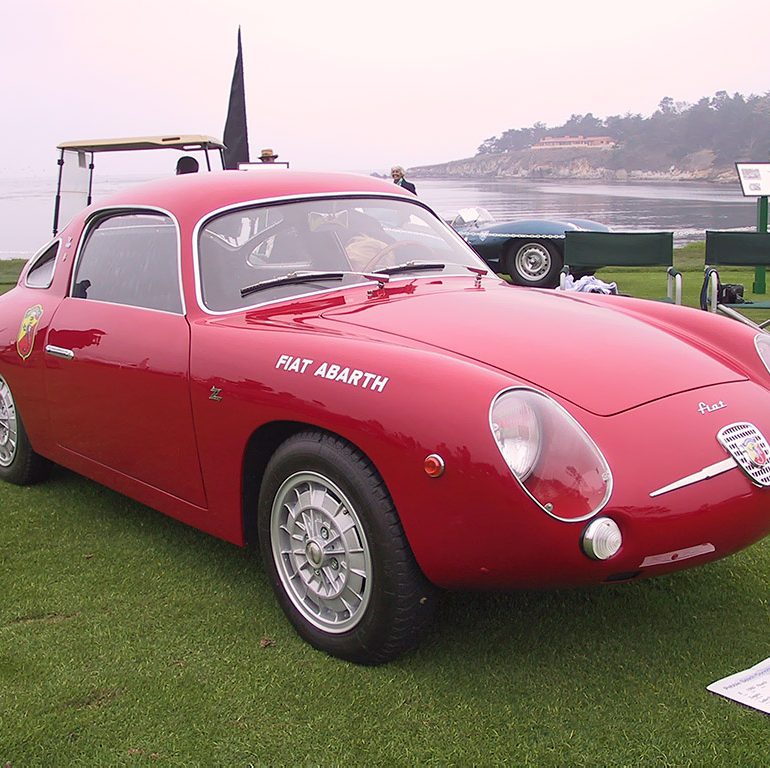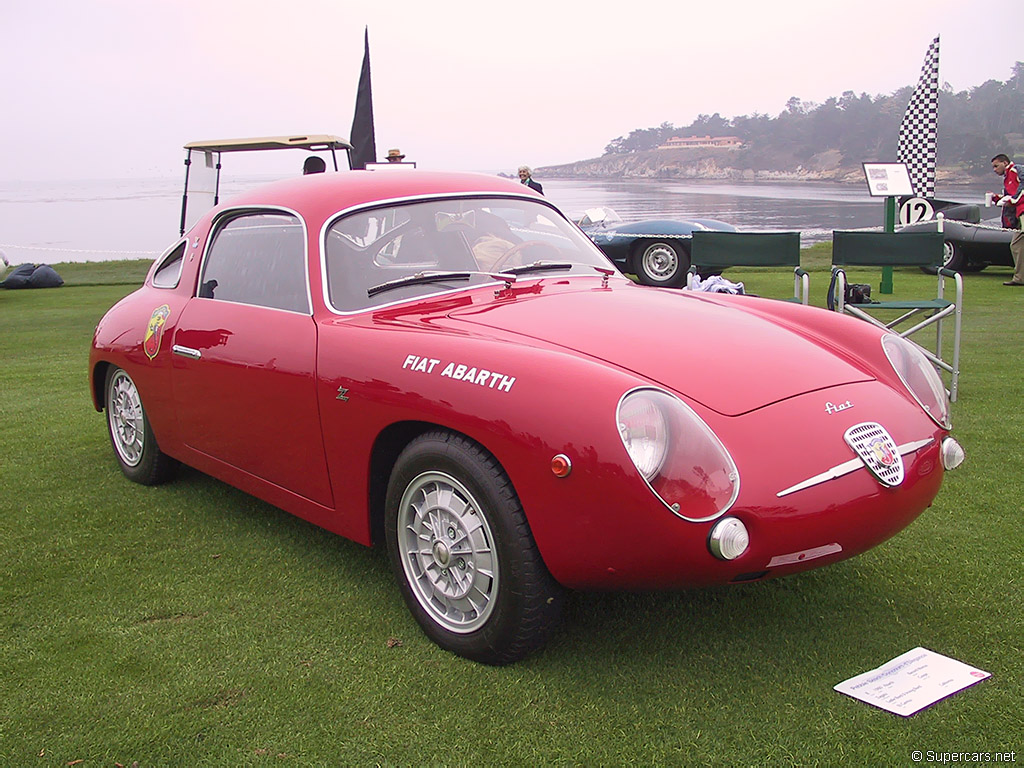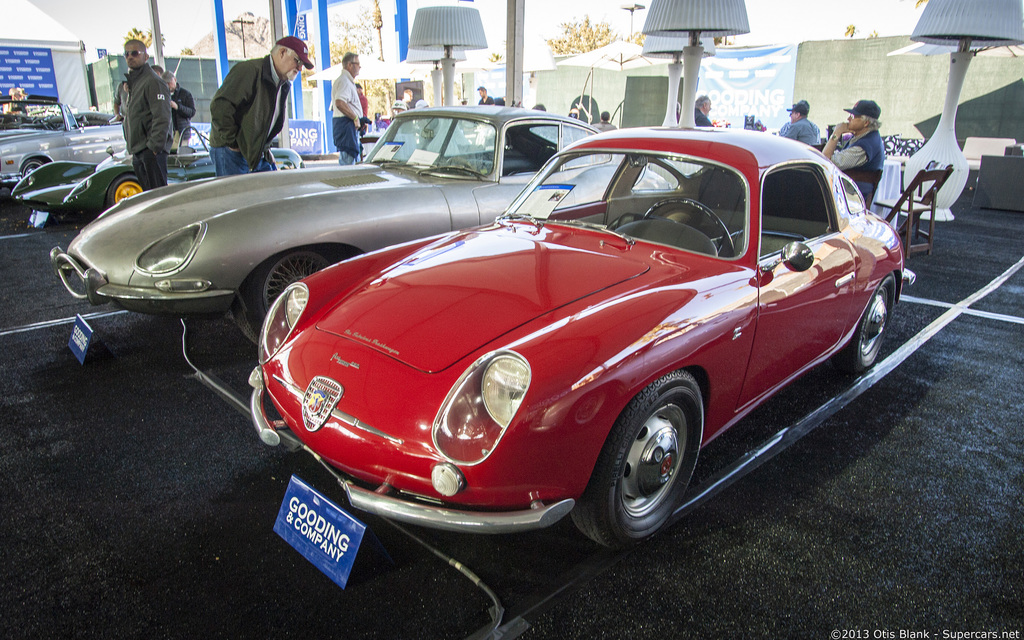1958 Fiat Abarth 750 Record Monza Zagato
In 1958, Abarth updated their small ‘750 GT Zagato’ racecar and renamed it ‘750 Record Monza Zagato’. The biggest upgrade was a new DOHC cylinder head that was specially designed for the Fiat 600D engine. As early as 1956, Abarth had already built up a reputation as a premier tuner of Fiat engines and was branching out into many classes of motor sport. To compete in the 750cc class of the Grand Touring Championship, Abarth commissioned Zagato to rebody the Fiat 600 into a purposeful racecar.
Thanks to Zagato’s weight saving body, the first cars weighed 1179 lbs (535 kg) and took advantage of Abarth’s 747cc tuned engine. With a high compression head and specially made exhaust, the power was rated at 47 bhp @ 6000 rpm. A number of prototype cars were made in 1956 and one of these appeared at the 1956 Mille Miglia to place second in class.
The production ‘Zagato 750 GT’ debuted at the 1956 Geneva Motor Show and the first cars were sold at the beginning of 1957. The final design included twin bumperettes upfront, Zagato’s double bubble roof and twin intakes on the rear engine cover. Five of these cars finished the Mille Miglia in 1957 and Alfonso Thiele won the 750cc class.
In July of 1957, Abarth committed to fund a record-breaking car with a sleek Pininfarina-designed body, tube frame chassis and 747cc engine. Raced around the Monza circuit for four days, the car took 15 new records including the fastest average speed of 165.376 kph for 72 hours straight.
At the 1958 Paris Motor Show, Abarth launched and renamed the ‘750 GT Zagato’ into the ’750 Record Monza Zagato’. This was done to honor the results achieved a year earlier with the record breaking car. Along with the new name came design updates. The engine now had the specially-made DOHC cylinder head which raised horsepower to 57 bhp. Zagato also modified the rear end to include three-quarter windows. Included on the window post was a ‘Record Monza’ badge which was fitted to both DOHC and single cam cars. Zagato also opted for a standard roof over the double-bubble used on the first series of cars.
During the 1959 season, the more potent Record Monza racked up an impressive series of victories. Four of these cars contested the 12 Hours of Sebring entered by Team Roosevelt with complete factory support. The cars finished 1-2-3-4 and were predominantly featured in the American press. This success continued overseas, both in circuit racing and in hill clmbs.
The success with the Record Monza caught the world’s attention. In the following years, Abarth raced similar cars, powered by 850cc and 1-liter engines. Called Biaberos, they weren’t bodied by Zagato and instead finished at Abarth’s own workshops.
Bibliography and Further Reading
Braden, Pat & Schmidt, Greg. Abarth Fiat Simca Porsche Street Race Record, Osprey, United Kingdom: 1983.
Cosentino, Alfred. Abarth Guide, Nigensha Publishing, Japan: 1984.
Greggio, Luciano. Abarth, the man, the machines, Giorgio Nada Editoire, Italy: 2002.
In Detail
| type | Racing Car |
| built at | Turin, Italy |
| engine | Inline-4 |
| position | Rear, Longitudinal |
| aspiration | Natural |
| valvetrain | DOHC, 2 Valves per Cyl |
| fuel feed | 2 Twin-Choke Weber 36DCL4 |
| displacement | 747 cc / 45.6 in³ |
| bore | 61 mm / 2.4 in |
| stroke | 64 mm / 2.52 in |
| compression | 4.3:1 |
| power | 42.5 kw / 57 bhp @ 7000 rpm |
| specific output | 76.31 bhp per litre |
| bhp/weight | 100.0 bhp per tonne |
| driven wheels | RWD |
| front tires | 5.20×12 |
| rear tires | 5.20×12 |
| front brakes | Drums |
| rear brakes | Drums |
| steering | Worm & Sector |
| f suspension | Upper Trailing Arms w/Lower Transverse Leaf Spring, Hydrualic Dampers |
| r suspension | Trailing Arms w/Coil Springs, Hydraulic Dampers, |
| curb weight | 570 kg / 1257 lbs |
| wheelbase | 2000 mm / 78.7 in |
| front track | 1150 mm / 45.3 in |
| rear track | 1160 mm / 45.7 in |
| length | 3470 mm / 136.6 in |
| width | 1350 mm / 53.1 in |
| height | 1140 mm / 44.9 in |
| transmission | 4-Speed Manual |
| top speed | ~190 kph / 118.1 mph |






